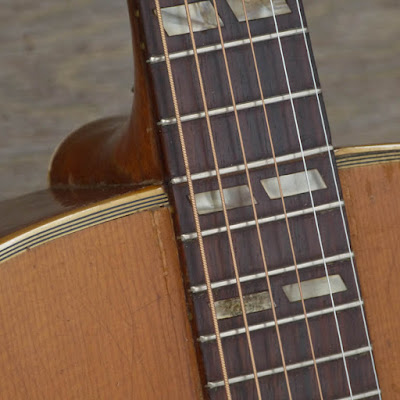1952 Gibson Southern Jumbo Slope Dread Guitar
This is a customer's guitar and has definitely seen some use and abuse over time. The factory order number at the neck block clearly states that it's (apparently) a 1952 build, though the natural top would've been an oddity for that year (I'm sure it's original finish, though) and it has a fairly narrow (1 5/8") nut width and the leavings of a later-style, bigger "point" pickguard on the top. We at least know that it's lived a few different lives since it was built, right? Still, after work it's a gorgeous-sounding, full-on heartthrob to play.
Work included a neck reset and neck block reglue (it'd separated from the top), fret level/dress, some cleaning-up at the headstock (more on that down the post), a new bone nut and saddle, a seam repair at the endblock, and pin-hole fill/redrill job at the bridge. It got a new set of tuners and bridge pins, too.
The guitar's finish is still original, for the most part, and shows a few cracks on the top and back -- but overall the look is well-used but respectable.
Before work the headstock was pretty gross -- and I'll be honest, it still sort of is. Someone had done a lot of weird bondo-style filler jobs to (presumably) remove enlarged tuner holes for something like a Grover Rotomatic tuner install that'd gone horribly wrong. There was thus a bunch of weird white glop showing through a half-hearted attempt to hide it. I cover that over with some black and sprayed it a few times with nitro to at least keep the look "Gibson" from a short distance.
This guitar also had a cheapy, molded plastic nut installed (terrible to have to adjust and they wear poorly) and now it has a proper bone one. I swapped the 1960s Harmony-style tuners out (they were pretty funky) and filled/redrilled the screw mounting holes (which had been overdrilled like mad) to mount a set of Kluson-style repros in their place. I couldn't stomach the idea of going to all the trouble and then putting unstable tuners back on.
The rosewood board sports those cool faux-pearl inlays, as usual. The frets are original and on the smaller side, though they did have enough life left in them to do well after the fret level/dress.
This guitar is interesting in that the scale is 24 7/8" rather than the more-usual 24 3/4" Gibson scale. This happened back and forth in the manufacturing process with Gibs.
You can see stress hairline cracks on either side of the board where the unglued neck block had been shifting around.
An old "neck reset" had been attempted, too, in the past and the board extension over the body had been cut and reglued -- but the job was really shabby and the 14th fret was sticking up pretty high. When I did my reset and block repair I glued it back down properly, matching the height with the board itself.
The bridge itself was definitely shaved-down from the bottom in the past. This is not a big deal but the wings are very thin. The saddle area also had a rosewood shim installed to thin-up the area where the saddle would fit -- presumably this was to adjust it back a little with the neck block area mucked-about. I pulled that shim out and cut a new, thicker, compensated bone saddle.
After that I filled and redrilled the pinholes as they'd had that job done before -- but very out-of-line and higgledy-piggledy. The "string ramps" were also so worn that the ball-ends were pulling up through them and running over the new saddle at almost a 30-degree angle.
"Under the hood," this guitar has a replacement rosewood bridge plate installed. It's not my work but was at least competently-installed.
There appears to be a repaired old hairline crack in this region of the neck.
Update: This guitar now wears 40s-style Kluson strip tuners rather than these.
Update: This guitar now wears 40s-style Kluson strip tuners rather than these.
Interesting "staple" there, huh?
The "endpin" is cool in that it's a twist-down thumbwheel that will tighten up your strap for you. Someone's ingenious "early straplock," huh?
This guitar comes with what looks like a 70s Gibson hard case -- in good order.

















Comments